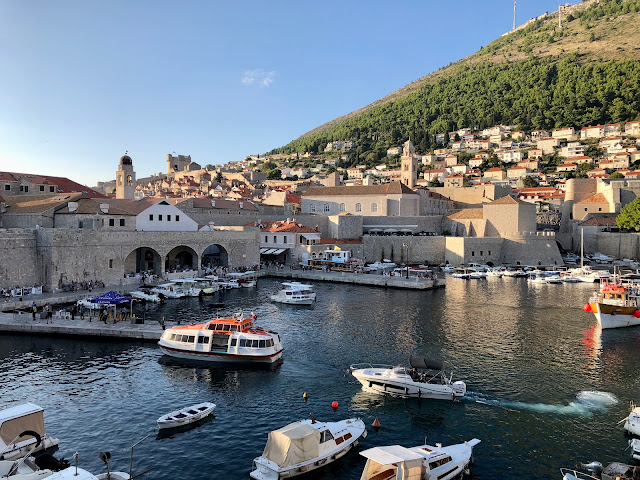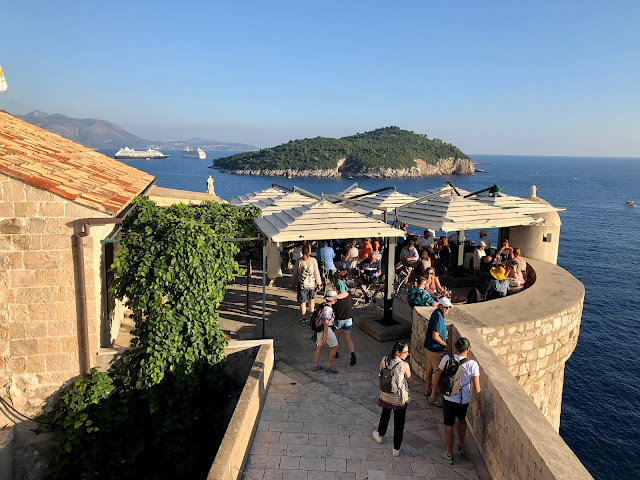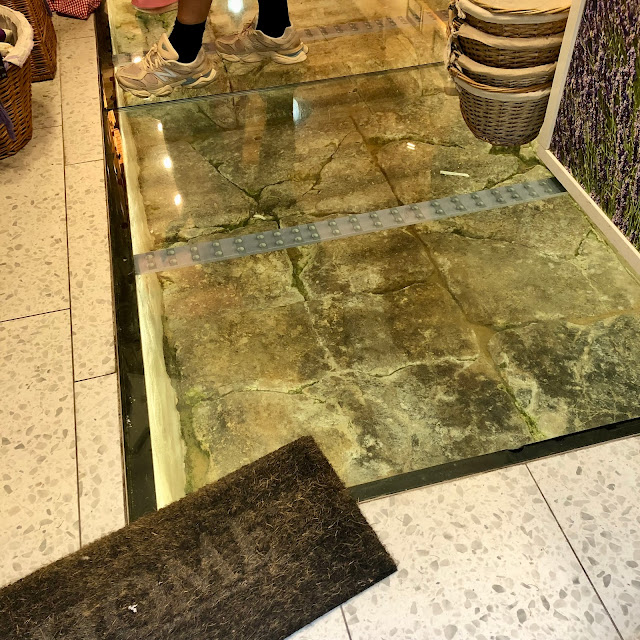There was a time in this world when all cities that had any means to defend themselves had walls. I don't mean like a token wall to define the boundary of the city proper or to distinguish the center of the city from the suburbs. I mean like a heavy duty, keep the bad guys out, tall and thick wall with battlements and large weapons. I mean like something fortified, scaling-and-assault resistant that was maybe behind a moat with large, big drawbridges at one or two gates which men with weapons guarded 24 hours a day to repel any sort of invaders or attackers. A city wall. Something formidable.
In most places today, those walls are gone, if they were even there in the first place. They are gone because quite simply there's just no need for them in today's world. Cities are no longer sieged by armies outfitted in chain mail with pikes and spears and swords and I guess in most places they were just in the way (the walls, not the pikes etc.). Maybe you can visit an historic city here and there that has fragments of the old city wall or in some other places it may be mostly intact. We found bits and pieces of the old wall in the city center of Barcelona in 2014 and we walked through centuries old gates in Marrakech just days before we traced the old Roman wall in Barcino. But most places? Completely gone. Disappeared. No chance.
"Most places" doesn't include the city of Dubrovnik at the south end of Croatia's Dalmatian coast. Dubrovnik is a museum piece of a city, a pre-medieval town that's evolved through the centuries into a densely packed stone town centered around a couple of broad thoroughfares and some important civic buildings. Its character has been affected by every empire it's been claimed by, from the Byzantines to the Venetians to the Ottomans to Napoleon's France. At one time in history it housed 6,000 citizens but today that number is about 1,000, if you don't count the hordes of tourists that pack the city daily and leave after they have seen what they came to see.
That last category, of course, included us this year, although I like to think there's a difference between us and the packs that pile off buses from cruise ships docked just outside the city. Maybe I'm being a snob.
Dubrovnik is a manageable city for a visitor. I think you could probably walk most every street in a day if you tried, from the main stone streets worn smooth by millions of feet and sandals and shoes and flip flops over centuries of use to the tiniest alleyways with glimpses into restaurants and stores and people's lives. You'd certainly get a great workout if you do. Dubrovnik is hilly, with massive steps taking you from the main squares to the city's edge. There is so much history and food and architecture to find and discover, from the city's most important buildings to the tiny bars clinging to the shores of the rock that the city is built upon.
Oh...and they have a pretty amazing city wall. It's completely intact and it's all walkable. And it's spectacular.
 |
| The start of our wall walk. Tower of the Dominican Monastery and the Cathedral dome in the bottom pic. |
We knew before we visited Dubrovnik that we'd find ourselves a city with a remarkable wall surrounding it. Even so, when the city first came into view from the back seat of our cab that was taking us from the city's ferry terminal to our hotel just outside the Pile Gate, I was astonished. It was honestly, and I know this is terrible to say (or write), like the real-life manifestation of the Las Vegas Excalibur Hotel. That was the first thought that popped into my head and I know I'm a better tourist than that but that's all I could think of immediately. It was the grossly oversized turrets and walls that went straight up capped by a crenellated wall top, I think. The cartoonish rendering of a castle on the Las Vegas strip I guess is based on reality.
Dubrovnik, of course, is way better than any hotel on the Las Vegas strip. It's real. There's history there. And there is a lot to see and study. The only thing that's better than walking in the city itself is walking around the city from the top of its most impressive wall. Towards the end of our second day in town, we climbed the steps at one of the entrances to the wall walk at the east side of the city and started walking. Counterclockwise. One-way ticket. You can't go the other way.
I'm not putting down Vegas, by the way. I love Vegas and the whole Vegas strip is every bit as good as Dubrovnik but in a totally different way. But one hotel vs. Dubrovnik...Dubrovnik wins!
I've already mentioned Dubrovnik is on a hill, right? So, of course, there's a workout aspect to the walls of Dubrovnik. Two kilometers or 1.2 miles. And obviously it ain't all flat. Wear some comfy shoes that you feel good climbing stairs in. You'll need them.
 |
| Headed towards the Minčeta Tower. |
There are three access points to the wall in Dubrovnik: one just inside the Pile Gate (pronounced pee-lay, by the way, not pile) at the west of city; one near the Ploče Gate at the east side of the city; and a third just a bit south of the Ploče Gate near the old harbor. We picked the one near the Ploče Gate because we'd been told (if I'm remembering correctly) that it started you out on the upward slope (thus getting the hard part out of the way first) and that we would see the best parts of the wall first.
I guess the logic behind the best parts of the wall being counterclockwise from the Ploče Gate entrance was that you would reach the iconic Minčeta Tower at the northwest corner of the city quickest from that entrance. There is no doubt that as far as parts of the wall go, that stout circular corner tower is by far the star of the show. It looks like the most impenetrable part of the wall and it's more of an identifiable object in the round than any other place on the wall. It's also the highest point in the city and has the most sweeping views. And yes, you can actually climb to the top of that tower from the wall. There's no doubt it's impressive.
But best part of the walk? I don't know about that. After having circumnavigated the city just once, I have a few spots that I thought were better.
 |
| Three towers on the Dubrovnik skyline (top); Onofrio Fountain (middle); and the old Dubrovnik harbor (bottom). |
To me, the best part of walking the wall was not looking at the wall, it was looking from the wall out over the landscape surrounding the city or inward to the white-walled, red-tiled buildings that are packed within the heavy donut that is the wall. There are some views along the walk that are spectacular and which are far superior (in my opinion) to the Minčeta Tower. For my money, the best part of the walk was along the southern side of the wall.
That part of the wall starts at the west corner of the city with a picture postcard view of Fort Lovrijenac, the 11th century fort built in three months by the people of Dubrovnik to guard the city from land or sea attacks from the west, and it ends at the eastern corner with a close-ish up view of the island of Lokrum, site of a medieval Benedictine monastery and a fort built by Napoleon's troops in the early 1800s. In between those two points you get unbroken views of the gorgeous waters surrounding Dubrovnik and looking back towards the city, you can see the entire place laid out before you as you look back up the hill towards Minčeta Tower. Yes, I realize I just pooh-poohed the conventional wisdom of Minčeta Tower being the thing to see on the wall. But I guess I really do agree, but I prefer to see it in context of the entire fortress that the wall creates. The place to do that in my opinion is from the southern side of the wall.
There are two other reasons why I loved the southern side of the wall the best. First, the profile of the wall along that edge dips and climbs and is narrow in parts and thickens in others. I can tell you there's no way I'd want to be stationed on the wall along the section just east of the western terminus; it is so thin and unsheltered. There was nowhere to hide on that portion of the wall. You'd be a sitting duck for any well-skilled archer.
Second, one of the cool things about walking around Dubrovnik today is that there are one or two tiny doorways in the sea-side wall for people to sneak through and either access the water or hang out in one of the bars that is clinging to the rocks at the base of the city walls. Not only does the south side of the wall get you great views of the city and of Fort Lovrijenac, you can also spy down on the people hanging out in these tiny watering holes.
And of course, it should go without saying that I don't really want to be on any sort of wall during an attack with missiles of any sort. But there...I just said it anyway.
 |
| The front wall of the Church of St. Ignatius. |
But that's not even the best part of the wall walk. For me, my enduring memory of Dubrovnik is that it is a city of towers and domes. The wall walk emphasized and reinforced that impression and got me a different perspective on the city to preserve that memory.
Dubrovnik is incredibly homogeneous as a city. It's white stone and red tiles. I know I've already said that a couple of times. 98% or 99% of it is that simple. It is stone buildings crammed inside the wall with the minimum circulation space between buildings necessary for a city to function adequately. When you walk around the city or look down on it from any point on the wall, mostly what you see is red and white. Even the streets are paved with white stone.
But then there are a series of towers that rise above all that and serve as landmarks and guideposts to pull you through the city. Enter the city through the Pile Gate at the western edge of the city and your anchor tower is the belltower of the Franciscan Monastery (construction started in 1317). Standing at the other end of the town's main boulevard is the City Bell Tower (originally constructed 1444) to draw you into the city. At the Bell Tower end of the promenade, you can head north to the belltower of the Dominican Monastery (established in the 16th century) or south to the dome of the Cathedral of the Assumption of the Virgin Mary (12th century, but mostly destroyed in the earthquake of 1667 and rebuilt). The Cathedral is the most important church in the city but it's not the highest point on the south side of the city. That honor goes to the sculpted facade of the Church of St. Ignatius, which from the wall, becomes another iconic high point in the city fabric without actually being a tower.
As you walk around the walls of the city, all five of these towers (I'm counting the Cathedral dome and the front wall of St. Ignatius as towers here...) stand out boldly, get hidden and then reveal themselves anew before being concealed again. There are spots on the walk where you can see all five, but usually at least one is out of sight here and there before popping into view between buildings or when you turn a corner. After the southeast corner of the wall walk, it's a game of hide and seek with the City Bell Tower, Cathedral Dome and wall of the Church of St. Ignatius. It is difficult in a city as dense as Dubrovnik to get good looks at these pieces and parts of these most important structures in the city from the ground level. The wall helps get a different perspective on these things. There are some glorious suprises as you walk the wall.
 |
| South wall of the city (top); dome of the Cathedral of the Assumption of the Virgin Mary (bottom). |
One of the other things you notice as you walk is that you are clearly transiting past places where people live. Sometimes you might see a couple on an outdoor porch of sorts having a drink or get a glimpse of some garden furniture or a string of laundry hung out to dry. We visit places like Dubrovnik and are astounded by their history and utter contrast with the places we call home; we forget sometimes that these places we spend a week or a few days of our lives are places other people call home. Getting views into their lives as we as tourists tramp around their neighborhood is almost voyeuristic but I have to think it would be cool to have a place to live inside Dubrovnik's city walls. Althought I definitely wouldn't want to contemplate moving furniture in or out or even carrying groceries back home. There's no cars or garages inside the city wall. It's all on foot with bags of groceries. Or furniture.
Some people, by the way, have strung laundry lines from the walls of their homes on one and have used the city wall as the other end. The anchors they have placed in the wall are more than ten or fifteen feet high in some spots. I guess if you have no dryer you have to do this.
There's one other spot on the wall worth stopping and watching and that's near the Pile Gate at the west side of the city. Just inside that gate there is a fountain called the Large Onofrio Fountain. It's not a fountain in the sense that I think of fountains, meaning a large open pool of water with some fancy sculptures and spouts of water shooting everywhere. This one is a large round structure with ports around its perimeter to allow Dubrovnik residents access to clean water. It's purely functional but it's of course not just that because it was built in 1438 and so it's adorned with sculptural elements around the water dispensers and columns equally spaced around its perimeter. It's also topped with a masonry dome which is cool to see.
The difficulty in viewing the Onofrio Fountain from the streets of Dubrovnik is that you can't take all of that in from ground level. But you can from the wall. From the wall, you can appreciate the whole thing. And do some people watching at the same time if you want.
Walking around the city wall is hot and thirsty work, especially with that Mediterranean sun beating down on you. You might want to fill your water bottle at the Onofrio Fountain before setting out on your two-kilometer hike. There's no doubt you'll need some sort of hydration at some point on that circuit. If you forget to fill up, or if you forget your water bottle entirely, don't worry. There are rest stops along the wall where you can get a drink of water or maybe something more adult. There are actually four bars along the walk, and validating my asseriton that the south side of the wall is the best, two of the four are along that side, with a third being awfully close on the west side near the old harbor.
We didn't stop at any bars along the way. We hustled. We got onto the wall late in the day and knew we'd have to move to cover the whole thing before they kicked us out. We also were getting hungry and had a recommendation on a good spot to get some cuttlefish risotto. All told, our complete walk took us about 65 minutes, with stops at least for a few moments at every spot worth stopping. I'm sure you could take way longer.
 |
| Bars with views. Lokrum Island in the bottom picture. |
The next night we were sat eating dinner in a spot where we could see the hammers hitting the bells at the top of an hour. We might not have watched if we hadn't realized how that worked. We wouldn't have known that if we hadn't have walked the wall. We spent just three nights in Dubrovnik. Every minute was packed. But the wall walk pulled everything together for me and gave me a series of photographs that will help me remember all three days we were there.
One last note to close this post. Dubrovnik today is a peaceful, calm city on the water along a beautiful coastline. It would be easy to think that the city's wall hasn't kept invaders out in centuries. But that's not true. As recently as the early 1990s the city was shelled by the Serbs after Croatia seceded from what used to be Yugoslavia. Those perfect old buildings were under attack 30 years ago by mortar shells. Things can change so quickly. Appreciate where you are in times of peace and calm. It wasn't always that way. In some places really recently.
 |
| City Bell Tower, Dubrovnik. |

























